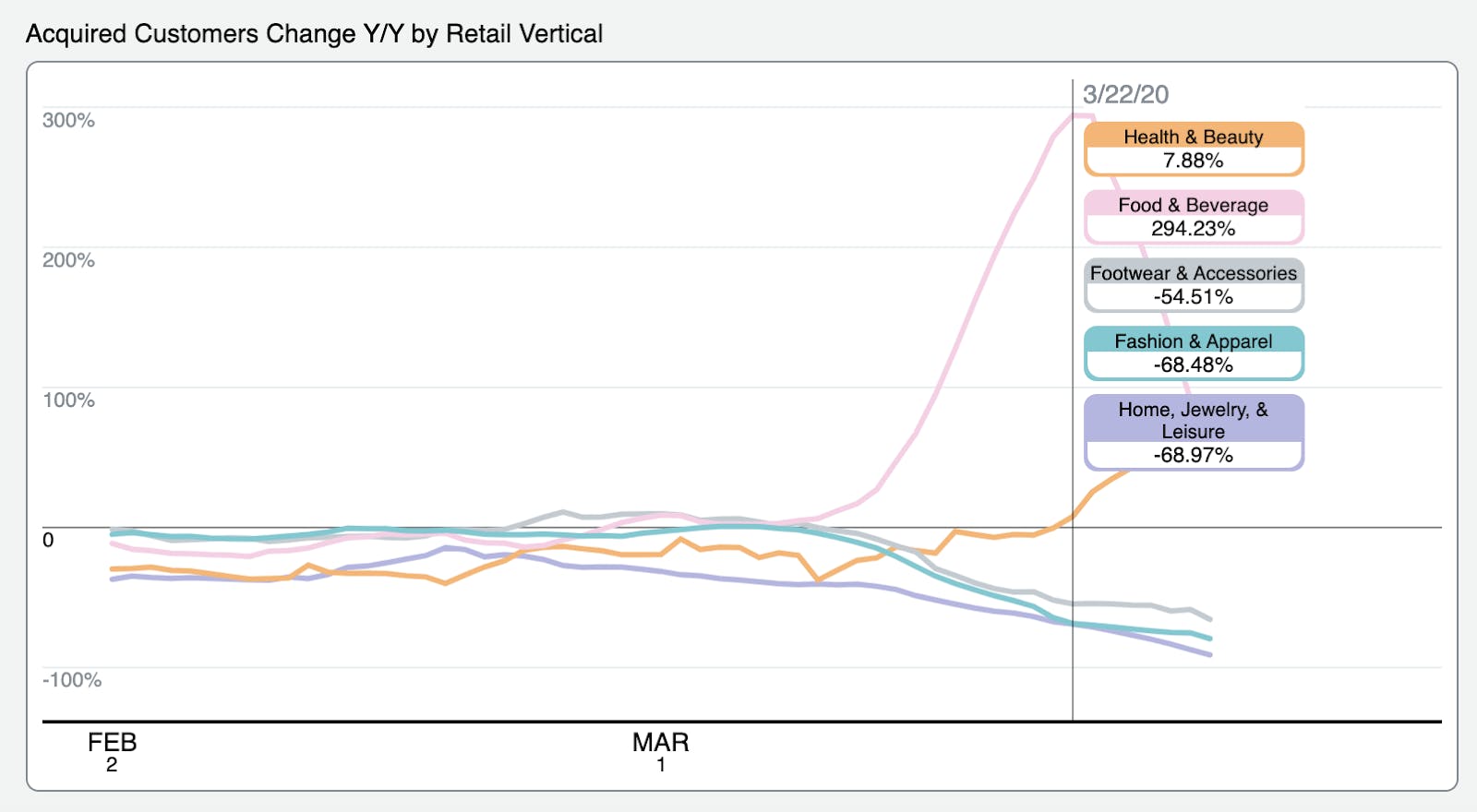For every brand on the planet, these are unprecedented times. But the challenges and opportunities take on different forms depending on your industry. For example, some retail brands are experimenting with curbside pick up and enhancing their eCommerce sites. Others, like grocers, beverage brands, health & beauty, and pharmacies, are serving higher volumes and varieties of customers than ever before.
Below is a graph, where we can see the year over year change in newly acquired customers by retail vertical. For Food & Beverage brands, there was a peak on March 22nd where they collectively acquired nearly 300% more new customers than the previous year. While the percentage dropped later on, it was still 42% higher than last year by March 29th.
On March 27th, Health & Beauty saw 69% more new customers than the year before. We’re watching that trend line closely to see if it climbs further in April (sidenote: I personally bought a lot of e.l.f makeup after seeing myself on too many hours of Zoom closeups).

For hundreds of additional insights and metrics, check out Amperity's Retail Monitor, an always-on tracker of the latest industry trends
How to Build a Long-Term Relationship with Your Newest Customers
Some of these customers are purchasing online, but more often than not Health & Beauty and Food & Beverage customers are transacting in brick and mortar stores using a credit card. In essence, this makes them anonymous customers, sharing only a first and last name, their purchases, and a hashed credit card number (which means you can’t identify them as individuals and build a direct relationship).
So how do we get to know these new customers and make the relationship with them less, well, transactional? The key lies in a few foundational steps to ensure that these customers continue to love your brand for the long haul.
Step One: Know who is who
The first step is to get to know everyone a bit better, which can help you identify up to 50% of your anonymous store shoppers. This is done by comparing your in-store transaction file against your existing database or loyalty program. Where there’s a “key” like an email address given at checkout, you can join records on that and get a clear picture of the individual.
Most of the time, however, this doesn’t exist, so you’ll need to probabilistically match your transactional data against your existing database and a third party data asset that’s available through many data providers and includes individuals’ names and home addresses. This will allow you to find the individuals who live within a tight radius of the store they shopped at, so you can reveal a bit more about who they are and how to reach them.
Step Two: Nurture them
Once you know who is who, you can use that information to build a great relationship with every individual. The two channels you have available to you using this approach are direct mail and paid media (using an onboarder).
But before you blast out a generic communication, take the time to understand and segment your customers. Modern marketing is precise marketing, with increased demand from consumers for personalized experiences. Speak to what motivates a given customer: maybe they are motivated by discounts; maybe they are older and looking for special shopping hours; maybe they are partial to a particular product category. Use this knowledge to design offers that delight and serve them as unique individuals.
Step Three: Encourage loyalty
Now that your new customers have more experience with your store you can encourage a long-term relationship through your loyalty program. This first requires that you’ve got the right incentives in place to make joining worth their while. Then you have to promote it to the right individuals — generally this includes people who aren’t yet in your loyalty program but share characteristics with those who are.
The world may feel turned upside down, but people still need to shop for the things they need. This is a chance to give them a good experience that will make them want to stay with you during this rough stretch and stay with you when things get back to normal.
Read here how a fortune 500 brand used this method to identify anonymous customers and improve customer experience.
